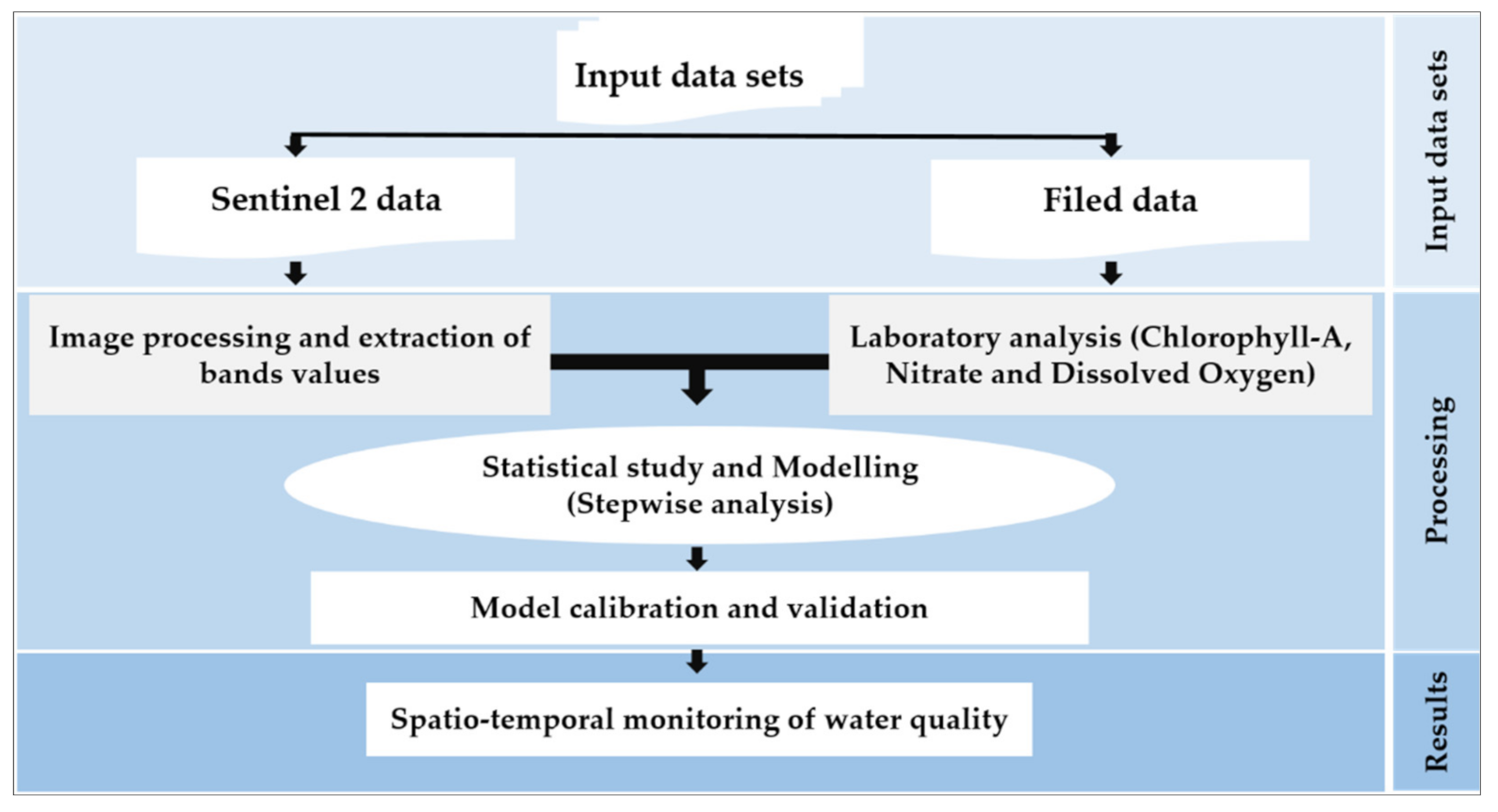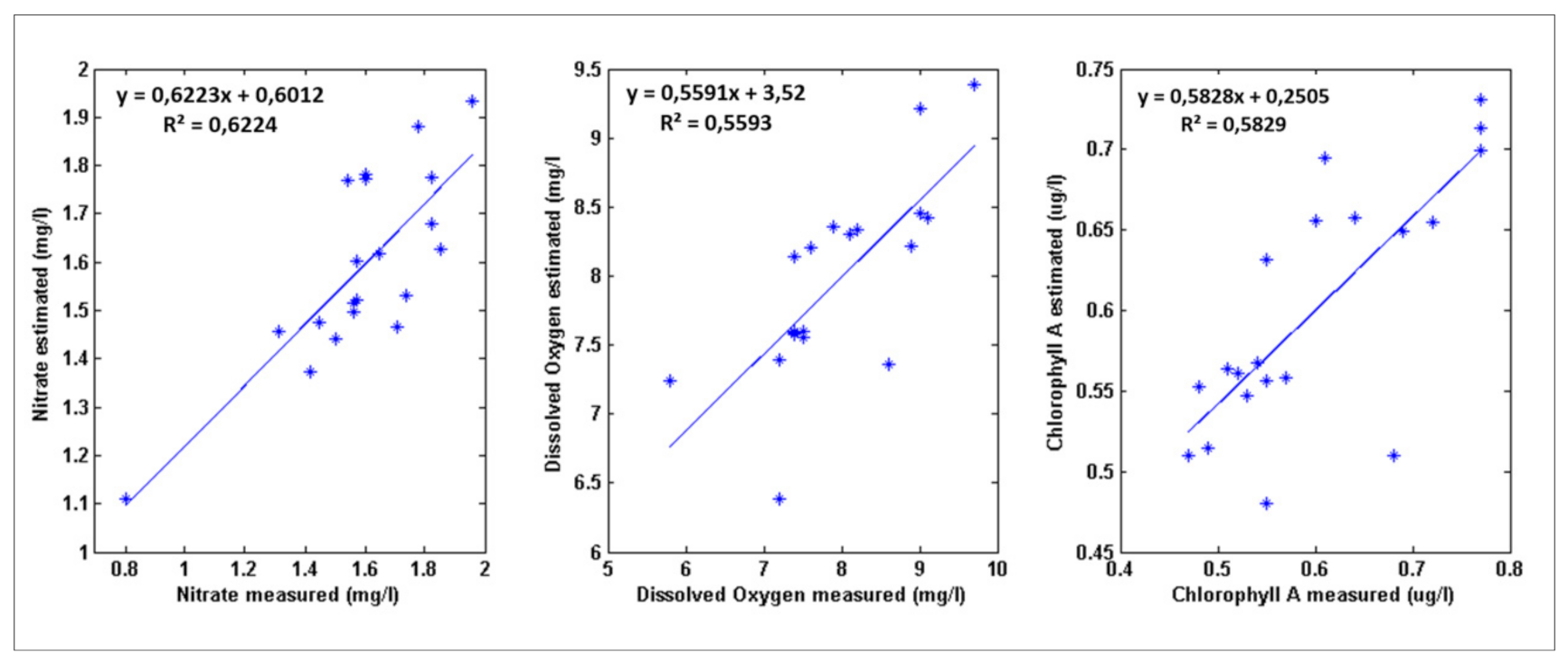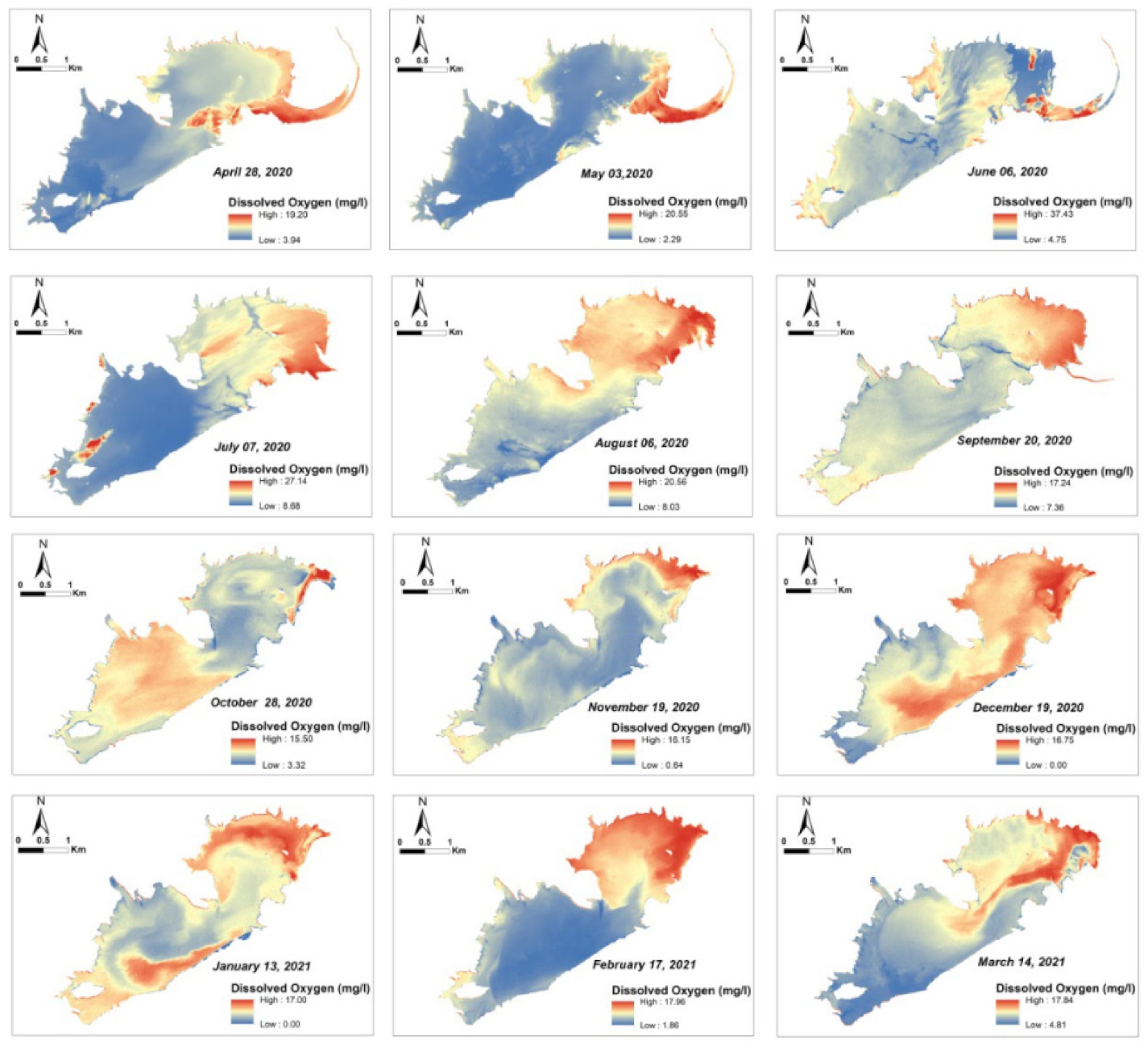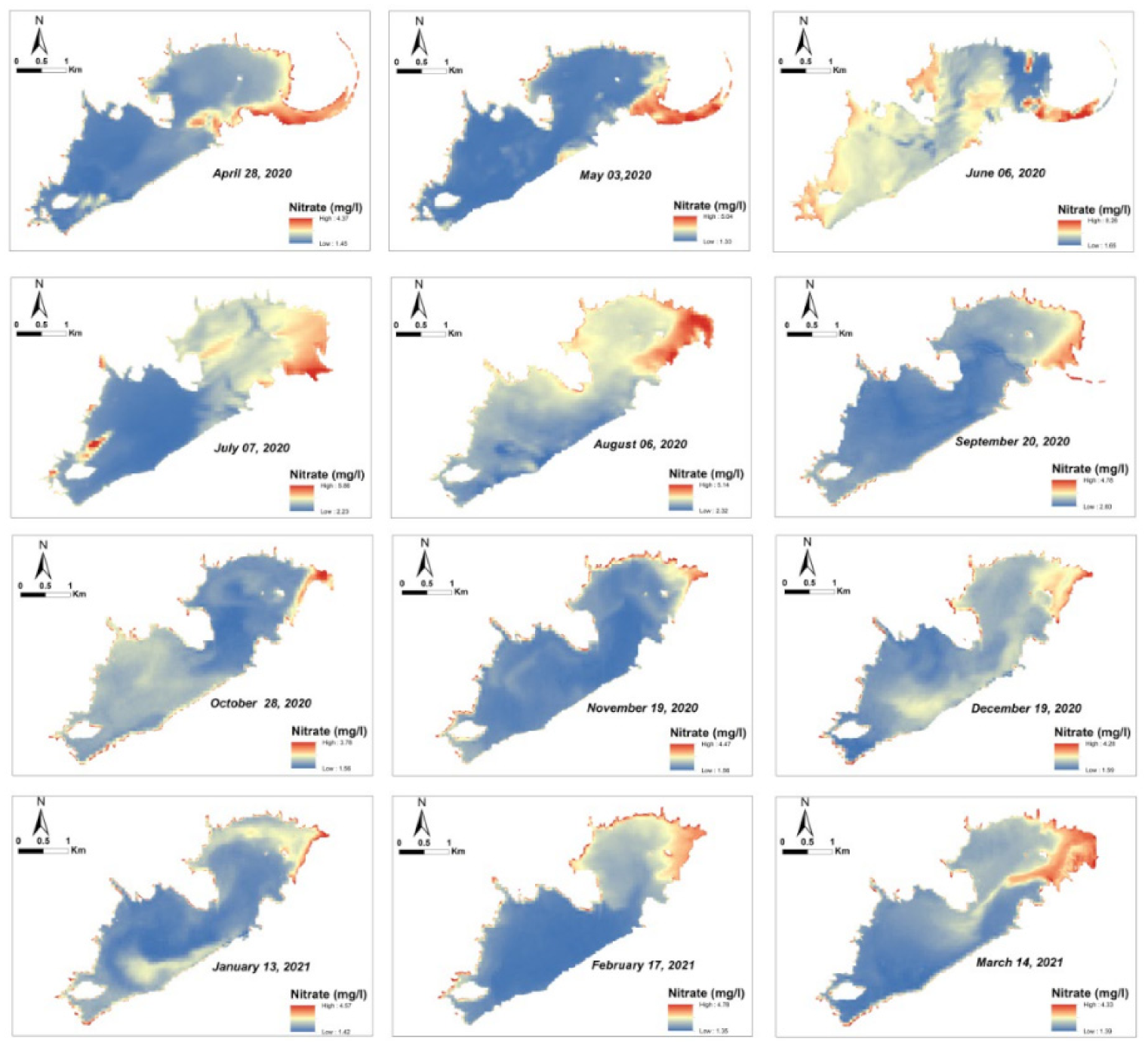Modeling and Spatiotemporal Mapping of Water Quality through Remote Sensing Techniques: A Case Study of the Hassan Addakhil Dam
Abstract
:1. Introduction
2. Materials and Methods
2.1. Study Area
2.2. Data
2.2.1. Ground Data
2.2.2. Satellite Data
2.3. Methodology
3. Results
3.1. Model Assessment and Validation
3.2. Spatial Variation of Water Quality
4. Discussion
5. Conclusions
Author Contributions
Funding
Institutional Review Board Statement
Informed Consent Statement
Acknowledgments
Conflicts of Interest
References
- Haut-Commissariat au Plan. Prospective Maroc 2030—Eveil aux problématiques du Maroc 2030—Rapport; Haut-Commissariat au Plan: Casablanca, Morocco, 2007.
- Brönmark, C.; Hansson, L.A. Environmental issues in lakes and ponds: Current state and perspectives. Environ. Conserv. 2002, 29, 290–307. [Google Scholar] [CrossRef] [Green Version]
- Karaoui, I.; Abdelghani, B.; Arioua, A.; Hssaisoune, M.; Sabri, E.M.; Ait Ouhamchich, K.; Elhamdouni, D.; El Amrani, I.; Nouaim, W. Evaluating the potential of Sentinel-2 satellite images for water quality characterization of artificial reservoirs: The Bin El Ouidane Reservoir case study (Morocco). Meteorol. Hydrol. Water Manag. 2019, 7, 31–39. [Google Scholar] [CrossRef]
- Tranvik, L.J.; Downing, J.A.; Cotner, J.B.; Loiselle, S.A.; Striegl, R.G.; Ballatore, T.J.; Dillon, P.; Knoll, L.B.; Kutser, T.; Larsen, S.; et al. Lakes and reservoirs as regulators of carbon cycling and climate. Limn. Oceanogr. 2009, 56, 2298–2314. [Google Scholar] [CrossRef] [Green Version]
- Moss, T. Spatial fit, from panacea to practice: Implementing the EU Water Framework Directive. Ecol. Soc. 2012, 17, 1–12. [Google Scholar] [CrossRef] [Green Version]
- El Hafyani, M.; Essahlaoui, A.; Van Rompaey, A.; Mohajane, M.; El Hmaidi, A.; El Ouali, A.; Moudden, F.; Serrhini, N.-E. Assessing Regional Scale Water Balances through Remote Sensing Techniques: A Case Study of Boufakrane River Watershed, Meknes Region, Morocco. Water 2020, 12, 320. [Google Scholar] [CrossRef] [Green Version]
- Driouech, F.; Déqué, M.; Sánchez-Gómez, E. Weather Regimes-Moroccan Precipitation Link in a Regional Climate Change Simulation. Glob. Planet. Chang. 2010, 72, 1–10. [Google Scholar] [CrossRef]
- El Moçayd, N.; Kang, S.; Eltahir, E.A.B. Climate Change impacts on the Water Highway project in Morocco. Hydrol. Earth Syst. Sci. Discuss. 2019, 24, 1467–1483. [Google Scholar] [CrossRef] [Green Version]
- Ouatiki, H.; Boudhar, A.; Tramblay, Y.; Jarlan, L.; Benabdelouhab, T.; Hanich, L.; El Meslouhi, M.R.; Chehbouni, A. Evaluation of TRMM 3B42 V7 Rainfall Product over the Oum Er Rbia Watershed in Morocco. Climate 2017, 5, 1. [Google Scholar] [CrossRef]
- Philipson, P.; Kratzer, S.; Ben Mustapha, S.; Strombeck, N.; Stelzer, K. Satellite-based water quality monitoring in Lake Vanern, Sweden. Int. J. Remote Sens. 2016, 37, 3938–3960. [Google Scholar] [CrossRef] [Green Version]
- Krtolica, I.; Cvijanović, D.; Obradović, Đ.; Novković, M.; Milošević, D.; Savić, D.; Vojinović-Miloradov, M.; Radulović, S. Water quality and macrophytes in the Danube River: Artificial neural network modelling. Ecol. Indic. 2021, 121, 107076. [Google Scholar] [CrossRef]
- Liarico, A.J.M.; Dávila, V.O.R.; Tapia, Á.M.F.; Valdivia, J.Q.; Medina, S.A.Z. Bioenergetic and water quality modeling for eutrophication assessment of El Pañe Reservoir, Peru. Ecohyd. Hydrobiol. 2021, 21, 114–128. [Google Scholar] [CrossRef]
- Basnyat, P.; Teeter, L.D.; Lockaby, B.G.; Flynn, K.M. The use of remote sensing and GIS in watershed level analyses of non-point source pollution problems. For. Ecol. Manag. 2000, 128, 65–73. [Google Scholar] [CrossRef]
- Oseke, F.I.; Anornu, G.K.; Adjei, K.A.; Eduvie, M.O. Assessment of water quality using GIS techniques and water quality index in reservoirs affected by water diversion. Water-Energy Nexus 2021, 4, 25–34. [Google Scholar] [CrossRef]
- Pierson, D.C.; Strömbeck, N. A modelling approach to evaluate preliminary remote sensing algorithms: Use of water quality data from Swedish Great Lakes. Geophysica 2000, 36, 177–202. [Google Scholar]
- Wang, X.; Ma, T. Application of remote sensing techniques in monitoring and assessing the water quality of Taihu Lake. Bull. Environ. Contam. Toxicol. 2001, 67, 863–870. [Google Scholar] [CrossRef]
- Yang, M.; Merry, C.J.; Sykes, R.M. Integration of water quality modeling, remote sensing, and GIS. J. Am. Water Resour. Assoc. 1999, 35, 253–263. [Google Scholar] [CrossRef]
- Toming, K.; Kutser, T.; Laas, A.; Sepp, M.; Paavel, B.; Nõges, T. First Experiences in Mapping Lake Water Quality Parameters with Sentinel-2 MSI Imagery. Remote Sens. 2016, 8, 640. [Google Scholar] [CrossRef] [Green Version]
- Olmanson, L.G.; Bauer, M.E.; Brezonik, P.L. A 20-year Landsat water clarity census of Minnesota’s 10,000 lakes. Remote Sens. Environ. 2008, 112, 4086–4097. [Google Scholar] [CrossRef]
- Palmer, S.C.J.; Kutser, T.; Hunter, P.D. Remote sensing of inland waters: Challenges, progress and future directions. Remote Sens. Environ. 2015, 157, 1–8. [Google Scholar] [CrossRef] [Green Version]
- Brezonik, P.; Menken, K.D.; Bauer, M. Landsat-based remote sensing of lake water quality characteristics, including chlorophyll and colored dissolved organic matter (CDOM). Lake Reserv. Manag. 2005, 21, 373–382. [Google Scholar] [CrossRef]
- Kallio, K.; Kutser, T.; Hannonen, T.; Koponen, S.; Pulliainen, J.; Vepsälainen, J.; Pyhälahti, T. Retrieval of water quality from airborne imaging spectrometry of various lake types in different seasons. Sci. Total Environ. 2001, 268, 59–77. [Google Scholar] [CrossRef]
- Vanhellemont, Q.; Ruddick, K. Acolite for Sentinel-2: Aquatic applications of MSI imagery. In Proceedings of the ESA Living Planet Symposium, Prague, Czech Republic, 9–13 May 2016; pp. 9–13. [Google Scholar]
- Ansper, A.; Alikas, K. Retrieval of Chlorophyll a from Sentinel-2 MSI Data for the European Union Water Framework Directive Reporting Purposes. Remote Sens. 2019, 11, 64. [Google Scholar] [CrossRef] [Green Version]
- Brezonik, P.; Olmanson, L.G.; Finlay, J.C.; Bauer, M. Factors affecting the measurement of CDOM by remote sensing of optically complex inland waters. Remote Sens. Environ. 2015, 157, 199–215. [Google Scholar] [CrossRef]
- Toming, K.; Kutser, T.; Uiboupin, R.; Arikas, A.; Vahter, K.; Paavel, B. Mapping Water Quality Parameters with Sentinel-3 Ocean and Land Colour Instrument imagery in the Baltic Sea. Remote Sens. 2017, 9, 1070. [Google Scholar] [CrossRef] [Green Version]
- Soomets, T.; Uudeberg, K.; Jakovels, D.; Brauns, A.; Zagars, M.; Kutser, T. Validation and Comparison of Water Quality Products in Baltic Lakes Using Sentinel-2 MSI and Sentinel-3 OLCI Data. Sensors 2020, 20, 742. [Google Scholar] [CrossRef] [Green Version]
- Hansen, C.H.; Burian, S.J.; Dennison, P.E.; Williams, G.P. Spatiotemporal Variability of Lake Water Quality in the Context of Remote Sensing Models. Remote Sens. 2017, 9, 409. [Google Scholar] [CrossRef] [Green Version]
- Ritchie, J.C.; Zimba, P.V.; Everitt, J.H. Remote sensing techniques to assess water quality. Photogrammetric engineering & remote sensing. Photogramm. Eng. Remote Sens. 2003, 69, 695–704. [Google Scholar]
- Gholizadeh, M.H.; Melesse, A.M.; Reddi, L. A Comprehensive Review on Water Quality Parameters Estimation Using Remote Sensing Techniques. Sensors 2016, 16, 1298. [Google Scholar] [CrossRef] [Green Version]
- Kallio, K.; Attila, J.; Härmä, P.; Koponen, S.; Pulliainen, J.; Hyytiäinen, U.M.; Pyhälahti, T. Landsat ETM+ images in the estimation of seasonal lake water quality in boreal river basins. Environ. Manag. 2008, 42, 511–522. [Google Scholar] [CrossRef]
- Verpoorter, C.; Kutser, T.; Seekel, D.; Tranvik, L.J. A global inventory of lakes based on high-resolution satellite imagery. Geophys. Res. Lett. 2014, 41, 639–642. [Google Scholar] [CrossRef]
- Saberioon, M.; Brom, J.; Nedbal, V.; Soucek, P.; Cisar, P. Chlorophyll-a and total suspended solids retrieval and mapping using Sentinel-2A and machine learning for inland waters. Ecol. Indic. 2020, 113, 106236. [Google Scholar] [CrossRef]
- El Hafyani, M.; Essahlaoui, A.; Teodoro, A.C.; Mohajane, M. Modeling and mapping of soil salinity in Tafilalet plain (Morocco). Arab. J. Geosci. 2019, 12, 35. [Google Scholar] [CrossRef]
- El Ouali, A.; Mudry, J.; Mania, J.; Chauve, P.; Elyamine, N.; Marzouk, M. Present recharge of an aquifer in a semi-arid region: An example from the Turonian limestones of the Errachidia basin, Morocco. Environ. Geol. 1999, 38, 171–176. [Google Scholar] [CrossRef]
- Nouayti, N.; Khattach, D.; Hilali, M. Cartographie des zones potentielles pour le stockage des eaux souterraines dans le haut bassin du Ziz (Maroc): Apport de la télédétection et du système d’information géographique. Bull. Inst. Sci. Rabat Sect. Sci. Terre 2017, 39, 45–57. [Google Scholar]
- Muzirafuti, A.; Boualoul, M.; Barreca, G.; Allaoui, A.; Bouikbane, H.; Lanza, S.; Crupi, A.; Randazzo, G. Fusion of Remote Sensing and Applied Geophysics for Sinkholes Identification in Tabular Middle Atlas of Morocco (the Causse of El Hajeb): Impact on the Protection of Water Resource. Resources 2020, 9, 51. [Google Scholar] [CrossRef]
- El-Ouardi, H.; Boualoul, M.; Ouhaddach, H.; Habib, M.; Muzarafuti, A.; Allaoui, A.; Amine, A. Fault analysis and its relationship with karst structures affecting lower Jurassic limestone in the Agourai plateau (Middle Atlas, Morocco). Geogaceta 2018, 63, 119–122. [Google Scholar]
- Muzirafuti, A.; Boualoul, M.; Randazzo, G.; Lanza, S.; Allaoui, A.; El Ouardi, H.; Habibi, M.; Ouhaddach, H. The use of remote sensing for water protection in the karst environment of the Tabular Middle Atlas/the cause of El Hajeb/Morocco. In Earth Observation Advancements in a Changing World; AIT Series, Trends in Earth Observation; Chirici, G., Gianinetto, M., Eds.; Italian Society of Remote Sensing: Firenze, Italy, 2019. [Google Scholar]
- Lehner, B.; Liermann, C.R.; Revenga, C.; Vörösmarty, C.; Fekete, B.; Crouzet, P.; Döll, P.; Endejan, M.; Frenken, K.; Magome, J.; et al. High-resolution mapping of the world’s reservoirs and dams for sustainable river-flow management. Front. Ecol. Environ. 2011, 9, 494–502. [Google Scholar] [CrossRef] [Green Version]
- Dahir n°1-16-113 du 6 Kaada 1437 Portant Promulgation de la loi n°36-15 Relative à l’eau. Available online: http://www.sgg.gov.ma/Portals/0/lois/Loi_36-15_Fr.pdf?ver=2018-11-28-153115-853 (accessed on 24 September 2021).
- Congedo, L. Semi-Automatic Classification Plugin Documentation. Available online: http://rgdoi.net/10.13140/RG.2.2.25480.65286/1 (accessed on 1 October 2021).
- Chavez, P.S., Jr. An Improved Dark-Object Subtraction Technique for Atmospheric Scattering Correction of Multispectral Data. Remote Sens. Environ. 1988, 24, 459–479. [Google Scholar] [CrossRef]
- Schalles, J.F.; Gitelson, A.A.; Yacobi, Y.Z.; Kroenke, A.E. Estimation of Chlorophyll a from time series measurements of high spectral resolution reflectance in an eutrophic lake. J. Phycol. 1998, 34, 383–390. [Google Scholar] [CrossRef]
- Honeywill, C.; Paterson, D.N.; Hagerthey, S.E. Determination of microphytobenthic biomass using pulse-amplitude modulated minimum fluorescence. Eur. J. Phycol. 2002, 37, 485–492. [Google Scholar] [CrossRef]








| Sampling Data ID | Dissolved Oxygen (mg/L) | Nitrates (mg/L) | Chl-a (µg/L) | Sampling Data ID | Dissolved Oxygen (mg/L) | Nitrates (mg/L) | Chl-a (µg/L) |
|---|---|---|---|---|---|---|---|
| 01 | 7.4 | 1.82 | 0.55 | 11 | 7.5 | 1.57 | 0.47 |
| 02 | 9 | 1.57 | 0.77 | 12 | 9 | 1.56 | 0.55 |
| 03 | 7.6 | 1.56 | 0.51 | 13 | 9.1 | 1.6 | 0.69 |
| 04 | 8.2 | 1.65 | 0.61 | 14 | 9 | 1.82 | 0.57 |
| 05 | 7.9 | 1.31 | 0.48 | 15 | 8.6 | 1.54 | 0.64 |
| 06 | 5.8 | 1.45 | 0.77 | 16 | 9.7 | 1.78 | 0.52 |
| 07 | 8.1 | 1.5 | 0.54 | 17 | 7.4 | 1.74 | 0.72 |
| 08 | 7.4 | 1.42 | 0.60 | 18 | 7.5 | 1.96 | 0.68 |
| 09 | 7.4 | 1.6 | 0.49 | 19 | 7.2 | 1.71 | 0.77 |
| 10 | 7.2 | 0.8 | 0.53 | 20 | 8.9 | 1.85 | 0.55 |
| Sentinel-2 Bands | Wavelength (nm) | Spatial Resolution (m) |
|---|---|---|
| Coastal Aerosol | 442.7 | 60 |
| Blue | 492.4 | 10 |
| Green | 559.8 | 10 |
| Red | 664.6 | 10 |
| Vegetation red edge | 704.1 | 20 |
| Vegetation red edge | 740.5 | 20 |
| Vegetation red edge | 782.8 | 20 |
| NIR | 832.8 | 10 |
| Narrow NIR | 864.7 | 20 |
| Water vapor | 945.1 | 60 |
| SWIR-Cirrus | 1373.5 | 60 |
| SWIR | 1613.7 | 20 |
| SWIR | 2202.4 | 20 |
| Image | Acquisition Dates |
|---|---|
| 1 | 28 April 2020 |
| 2 | 3 May 2020 |
| 3 | 6 June 2020 |
| 4 | 7 July 2020 |
| 5 | 6 August 2020 |
| 6 | 20 September 2020 |
| 7 | 28 October 2020 |
| 8 | 19 November 2020 |
| 9 | 19 December 2020 |
| 10 | 13 January 2021 |
| 11 | 17 February 2021 |
| 12 | 14 March 2021 |
| B1 | B2 | B3 | B4 | B5 | B6 | B8 | |
|---|---|---|---|---|---|---|---|
| Chl-a | - | - | - | - | 0.81 | 0.71 | 0.73 |
| Nitrates | 0.73 | - | 0.69 | 0.73 | - | - | - |
| Dissolved Oxygen | - | 0.71 | 0.75 | - | - | - | - |
| Model Equations | RMSE | R2 | p-Value | |
|---|---|---|---|---|
| Nitrate | 0.00372 × B01 − 3.05 | 0.19 (mg/L) | 0.39 | 0.0030 |
| 0.00895 × B03 + 0.31 | 0.24 (mg/L) | 0.06 | 0.2945 | |
| 0.00114 × B04 + 0.630 | 0.19 (mg/L) | 0.39 | 0.0031 | |
| 0.00372 × B01 − (3.056 × 10−7) × B03 − 3.0593 | 0.20 (mg/L) | 0.39 | 0.0140 | |
| 0.00273 × B01 + 0.00084 × B04 − 2.53264 | 0.17 (mg/L) | 0.58 | 0.0067 | |
| 0.000412 × B03 + 0.00125 × B04 + 1.1273 | 0.20 (mg/L) | 0.40 | 0.0127 | |
| 0.003099 × B01 − 0.000944 × B03 +0.0010509 × B04 − 1.81 | 0.16(mg/L) | 0.62 | 0.0011 | |
| Dissolved Oxygen | 0.0128 × B02 - 8.324 | 0.75 (mg/L) | 0.30 | 0.0040 |
| 0.0102 × B03 - 6.704 | 0.63 (mg/L) | 0.55 | 0.0001 | |
| 0.00075 × B02 + 0.00989 × B03 − 7.09 | 0.65(mg/L) | 0.56 | 0.0009 | |
| Chl-a | 0.0007071 × B05 + 0.184 | 0.07 (µg/L) | 0.41 | 0.0022 |
| 0.0010213 × B06 + 0.3066 | 0.08 (µg/L) | 0.37 | 0.0042 | |
| 0.002332 × B08 − 0.15655 | 0.07 (µg/L) | 0.45 | 0.0011 | |
| 0.0004766 × B05 + 0.000591 × B06 + 0.144903 | 0.07 (µg/L) | 0.49 | 0.0029 | |
| 0.000423 × B05 + 0.001572 × B08 − 0.1589 | 0.07 (µg/L) | 0.55 | 0.0010 | |
| 0.000574 × B06 + 0.00167 × B08 − 0.1076 | 0.07 (µg/L) | 0.53 | 0.0015 | |
| 0.0003214 × B05 + 0.000378 × B06 + 0.0013207 × B08 − 0.126 | 0.07(µg/L) | 0.58 | 0.0024 |
Publisher’s Note: MDPI stays neutral with regard to jurisdictional claims in published maps and institutional affiliations. |
© 2021 by the authors. Licensee MDPI, Basel, Switzerland. This article is an open access article distributed under the terms and conditions of the Creative Commons Attribution (CC BY) license (https://creativecommons.org/licenses/by/4.0/).
Share and Cite
El Ouali, A.; El Hafyani, M.; Roubil, A.; Lahrach, A.; Essahlaoui, A.; Hamid, F.E.; Muzirafuti, A.; Paraforos, D.S.; Lanza, S.; Randazzo, G. Modeling and Spatiotemporal Mapping of Water Quality through Remote Sensing Techniques: A Case Study of the Hassan Addakhil Dam. Appl. Sci. 2021, 11, 9297. https://doi.org/10.3390/app11199297
El Ouali A, El Hafyani M, Roubil A, Lahrach A, Essahlaoui A, Hamid FE, Muzirafuti A, Paraforos DS, Lanza S, Randazzo G. Modeling and Spatiotemporal Mapping of Water Quality through Remote Sensing Techniques: A Case Study of the Hassan Addakhil Dam. Applied Sciences. 2021; 11(19):9297. https://doi.org/10.3390/app11199297
Chicago/Turabian StyleEl Ouali, Anas, Mohammed El Hafyani, Allal Roubil, Abderrahim Lahrach, Ali Essahlaoui, Fatima Ezzahra Hamid, Anselme Muzirafuti, Dimitrios S. Paraforos, Stefania Lanza, and Giovanni Randazzo. 2021. "Modeling and Spatiotemporal Mapping of Water Quality through Remote Sensing Techniques: A Case Study of the Hassan Addakhil Dam" Applied Sciences 11, no. 19: 9297. https://doi.org/10.3390/app11199297
APA StyleEl Ouali, A., El Hafyani, M., Roubil, A., Lahrach, A., Essahlaoui, A., Hamid, F. E., Muzirafuti, A., Paraforos, D. S., Lanza, S., & Randazzo, G. (2021). Modeling and Spatiotemporal Mapping of Water Quality through Remote Sensing Techniques: A Case Study of the Hassan Addakhil Dam. Applied Sciences, 11(19), 9297. https://doi.org/10.3390/app11199297












